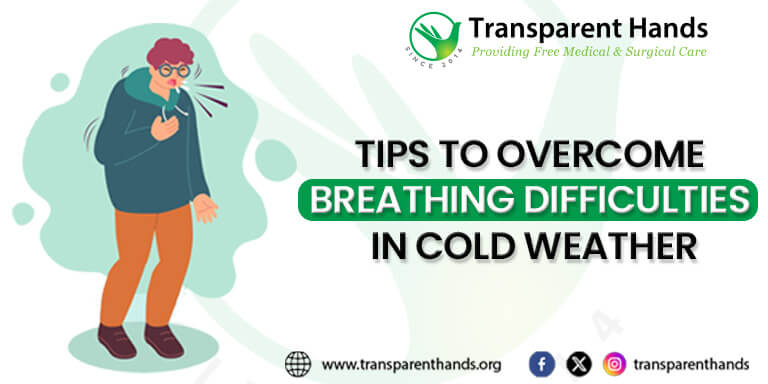Tips to Overcome Breathing Difficulties in Cold Weather

As winter engulfs our surroundings in a serene layer of frost, the crisp air brings with it a unique set of challenges, particularly for individuals prone to respiratory sensitivities. Breathing difficulties in cold weather can pose significant challenges, impacting the daily lives of many. In this blog, we’ll explore effective tips to navigate and overcome the challenges of breathing difficulties in chilly climates, empowering individuals with the knowledge to embrace the winter months with confidence and ease.
Understanding Breathing Difficulties in Cold Weather
Cold air can be harsh on the respiratory system, leading to various challenges, especially for those with pre-existing conditions such as asthma, chronic obstructive pulmonary disease (COPD), or bronchitis. The key factors contributing to breathing difficulties in cold weather include:
Airway Constriction: Cold air has the tendency to constrict the airways, making it harder for individuals to breathe, particularly if they have underlying respiratory conditions.
Dry Air Impact: Winter air is often dry, and this lack of humidity can irritate the airways, leading to discomfort and difficulty breathing.
Triggering Inflammation: Exposure to cold air can trigger inflammation in the airways, exacerbating respiratory symptoms.
Tips to Overcome Breathing Difficulties in Cold Weather
Stay Warm and Layer Up
Ensuring your body is adequately warm is the first line of defense against cold-related breathing difficulties. Layer your clothing to trap heat, paying extra attention to covering your chest and neck. Wear turtle necks, and layer them up with sweaters. If turtlenecks are a no-go for you, try wearing a scarf or a shawl around your neck.
How to Overcome the Common Diseases in Winters
Use a Scarf or Mask
Wrapping a scarf around your nose and mouth helps warm and humidify the air before it enters your airways. This simple barrier can make a significant difference in reducing the impact of cold air.
Breathe Through Your Nose
Breathing through your nose allows the air to be filtered, humidified, and warmed before reaching your lungs. This can be particularly beneficial in preventing the shock of cold air on your respiratory system.
Stay Hydrated
Hydration is essential, even in colder months. Drinking an adequate amount of water helps maintain the moisture levels in your airways, preventing irritation caused by dry air. Doctors recommend drinking a minimum of 7-8 glasses of water, daily.
Symptoms of Dehydration in Adults
A tip: We love snuggling with a hot cup of cocoa after a particularly chilly day. Consider investing in a hot chocolate mix powder to chase those winter blues away!
Use a Humidifier
Adding moisture to the air in your living spaces can be immensely beneficial. Humidifiers help combat the dryness of winter air, reducing the likelihood of respiratory discomfort.
Here’s a bonus incentive for using a humidifier. It will not only work wonders for your airflow but for your skin as well! The cold weather can dry out your skin and adding a humidifier in your surroundings will replenish the moisture in your skin.
Take Short Breaks Indoors
If the cold is particularly biting, consider taking short breaks indoors to allow your respiratory system to recover. This is especially crucial during vigorous outdoor activities.
Practice Controlled Breathing
Techniques such as pursed-lip breathing and diaphragmatic breathing can help manage breathlessness. These practices enhance the efficiency of your breathing, making it easier for your lungs to function.
Know Your Triggers
If you have a respiratory condition, identify and be mindful of specific triggers. Whether it’s allergens, pollutants, or cold air, understanding your triggers allows you to take proactive measures to minimize exposure.
Consult Your Healthcare Provider:
If you experience persistent or worsening breathing difficulties in cold weather, it’s crucial to consult your healthcare provider. They can assess your respiratory health, provide personalized advice, and adjust your treatment plan if necessary.
Conclusion
Navigating breathing difficulties in cold weather requires a proactive approach, incorporating lifestyle adjustments and awareness. By staying warm, hydrated, and mindful of specific triggers, individuals can not only overcome the challenges of winter breathing but also enjoy the seasonal beauty without compromise.
Remember, each person’s respiratory needs are unique, and consulting with a healthcare professional ensures that your approach is customized to your specific circumstances. With these tips in hand, embrace the winter months with confidence, knowing that you have the tools to breathe easy in even the chilliest of climates.
(The information in this article should not be taken as a substitute for professional medical advice.)










Leave Your Comments